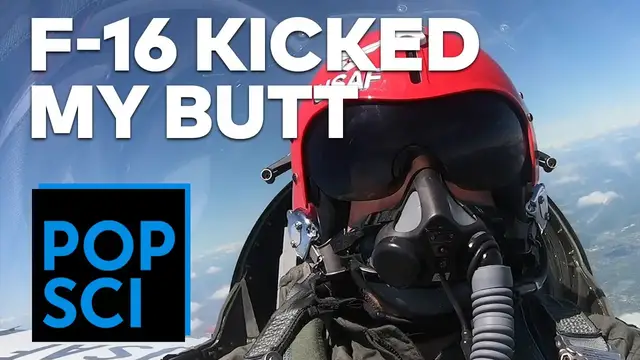0:00
I recently had the chance to fly in an F-16 fighter jet with the Air Force's elite demonstration team
0:05
the Thunderbirds. And while I'm truly grateful I had the chance to take to the skies with them, let me tell you
0:11
it did not go well for me. I threw up in the plane towards the end of the flight
0:15
I threw up after we got back on the ground, and then, for good measure, I threw up again
0:21
But even worse, the most significant and unpleasant sensations I felt in the plane came from something called G-forces
0:27
or, as the pilots call them, simply G's. So in the week since I landed, I've wondered
0:32
why did the flight kick my a-h-so hard, while professional pilots seem to have no problems at all
0:37
enduring the forces of the jet. We took off from MacArthur Airport on Long Island
0:41
My pilot, whose call sign is Flack, accelerated the jet to around 400 miles per hour
0:46
in a matter of seconds. He brought the nose up to about 60 degrees
0:50
and during our very steep, very rapid climb to 10,000 feet, 5.4 Gs pushed me back into my seat
0:57
So what is a G exactly? Well G stands for gravity and everyone on Earth feels one G pulling them down all the time When a high jet executes maneuvers like turning quickly or speeding up super fast
1:10
that change in acceleration physically pushes you back or even down in your seat
1:14
NASA astronauts generally experience around 3 to 4 Gs as their rockets blast off
1:19
although it can be more if something goes wrong. The F-16 jet I flew in is designed to hit the pilot with as many as 9 Gs
1:26
It's absolutely crucial for pilots flying fighter planes to manage the Gs they feel
1:30
Under high G forces, blood flows away from their eyes and brains, and their hearts start pumping harder and faster
1:37
If they don't properly cope, they could experience G-lock, which stands for G-induced loss of consciousness
1:42
The results can be disastrous. In addition to the experience and athleticism qualified fighter pilots already have
1:48
a major piece of equipment that these aviators use is a G-suit, which connects to the jet
1:53
When the aircraft senses its maneuvers are hitting you with Gs, the suit automatically inflates with air to squeeze your legs and abdomen
1:59
By doing so, it's designed to keep blood from pooling in your legs and feet
2:03
But the second tool is a technique that really separates flak and other fighter pilots from the rest of us It an exercise called the anti maneuver or AGSM Here how it works First you tense up your leg muscles and butt and then you stick out your belly
2:18
and you hold your breath while exchanging air in small bursts through your glottis
2:22
It's complicated, but it's kind of like this. By combining the AGSM with the squeeze of the G-suit
2:32
you can keep blood where it really needs to be, in your core, and in your
2:36
your brain. I had just one morning of training to learn the anti-G strain maneuver
2:41
Flack has years of experience doing it in fighter jets. The strain is second nature to him, and he's used to feeling all the forces the plane
2:47
throws at him. Pilots train in human centrifuges where they can perfect their AGSM technique and feel
2:52
the difference between doing it right and doing it wrong. During our flight, the maneuver that really owned me was a hard 180-degree turn over New Jersey
3:01
We experienced 6.2 G's, and I really, really did not like how it made it
3:06
me feel. Then Flack pulled the plane hard again to stay in our prescribed airspace
3:11
Right then I ripped off my mask because I thought I was going to puke Don worry I didn hurl then but as you know I definitely did later As for the air sickness that was caused by all the new sensations I experienced in the jet
3:23
The hard turns and, you know, things like flying upside down. On a more technical level, motion sickness is typically triggered by your inner ears
3:30
sensing the movement of your vehicle while your eyes see something different
3:34
Even though I could see landmarks like blue sky and the ground through the canopy window
3:38
I couldn't see straight out the front of the jet. The fact that flak was in control
3:42
of the aircraft and could thus anticipate its motions, puts me and any other backseater at a disadvantage
3:47
By the time we did a nice slow barrel roll, my brain and body felt like they'd been turned into scrambled eggs
3:54
Scramble eggs that had been vomited up three times to be precise
3:58
All told, it took me around a week to feel unscrambled. Flack, I'm sure, felt just fine



